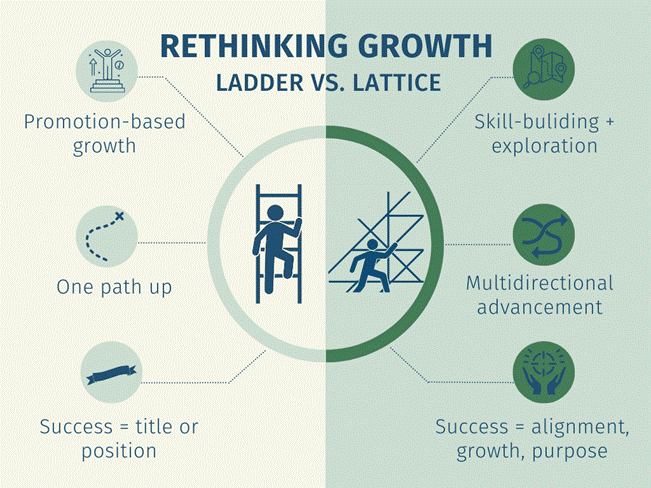
What do Barbie, Simone Biles and remote work have in common? They all represent seismic shifts that challenged norms, broke open old frameworks and invited us to imagine new possibilities. Whether it’s a legacy brand redefining itself for a new generation, an elite athlete choosing personal well-being over performance or millions of professionals adjusting to a reimagined workplace, we’re living in an era that demands not just resilience but reinvention.
This article explores how possibility thinking can serve as a compass in uncertain times, offering both inspiration and practical strategies to help CPD professionals navigate what’s next.
Reimagining Career Growth
Careers are increasingly moving away from the traditional ladder toward a flexible lattice, embracing lateral moves, skill-building and nonlinear growth. As Suzan McDaniel, CHRO of Edward Jones, advises, “Don’t think about your career as being linear. Think about it more as a lattice” (DiDomenico, 2023). This visual comparison highlights the shift from traditional promotion paths to more exploratory, purpose-driven progress.

This aligns with possibility thinking, a mindset that encourages curiosity, openness, and continuous learning. As Anna Craft describes it, “Possibility thinking is the practice of shifting our questions from ‘What is?’ to ‘What could be?’” (Craft, 2011).
For professionals in CME, CPD and mission-driven fields, this mindset is more than aspirational. This mindset is essential. It helps us overcome imposter syndrome, burnout and fear while empowering growth in unexpected directions. Rather than ignoring reality, it reframes it, enabling us to navigate ambiguity with intention.
As Rosamund Stone Zander writes in “The Art of Possibility,” “In the face of difficulty, we can despair, get angry or choose possibility” (Zander, 1994). That choice, while subtle, is transformational. Possibility thinking isn’t about toxic positivity; it’s about intentional reinvention.
Lessons From My Nonlinear Path
In healthcare and beyond, where change is constant and the stakes are high, possibility thinking enables CPD professionals to shift from fixed solutions to flexible approaches.
When I made the leap from continuing medical education strategy to nonprofit advocacy, I wasn’t leaving something behind. I was running toward something new: a challenge I welcomed, a mission I believed in and a space where I knew I could make a broader impact. The move was intentional, fueled by clarity and conviction but also by the mindset of possibility thinking. I wasn’t just switching sectors; I was reframing what was possible for myself.
Still, I’d be lying if I said the transition didn’t stir self-doubt. I’ve often carried imposter syndrome through different stages of my career, and this was no exception. What business did I have stepping into nonprofit leadership and advocacy? But possibility thinking reminded me that you don’t have to be the most experienced person in the room to make a difference. You just have to be open, grounded in your values and willing to move forward even when the path is uncertain.
I’m reminded of Molly Seidel, the Olympic marathon bronze medalist who battled imposter syndrome herself before lining up for the biggest race of her life. “I just wanted to come out … and stick my nose where it didn’t belong,” she said after the race (Hruby, 2021). That mentality resonates deeply with me. Like Molly, I’ve learned that when things get tough, that’s actually where I’m strongest. And possibility thinking is what allows me to meet those moments with purpose instead of fear.
As a long-distance runner myself, I’ve internalized a simple truth: confidence is earned through motion. You don’t wait until you feel ready, you take the step, trust your training, and build belief along the way. That same lesson has carried me through professional growth. Leaving a space where I was well established to enter a new arena was humbling but also energizing. I kept coming back to my core: My curiosity, my strategic strengths, and the deep belief that meaningful, value-aligned work is worth stretching for.
This shift wasn’t a departure but a recalibration. And embracing a possibility-oriented mindset is what turned uncertainty into an open road.
Insights From My Journey
- Confidence doesn’t come first — action does.
- Imposter syndrome doesn’t mean you don’t belong; it means you’re growing.
- Lateral moves can lead to exponential growth.
- Values and curiosity are more reliable guides than titles or timelines.
- When things feel hardest, that’s often where your strength shines through.
So how do we put this mindset into practice in everyday decision-making, leadership and career design?
How to Use Possibility Thinking
In a 2023 article for Psyche, Constance de Saint Laurent and Vlad Glăveanu outline practical steps for applying possibility thinking in everyday problem-solving. Below is a summary of the approach:
- Recognize the value of possibility thinking.
This mindset can support both personal and professional growth. By applying possibility thinking, you create a map of solutions not all immediately visible, but potentially achievable.
- Ask yourself, “What for?”
Begin by clarifying your goal. Before mapping out possibilities, understand what you truly want to achieve.
- Ask, “What if?”
With pen and paper, start imagining solutions that could exist if certain constraints were removed. This exercise helps unlock creative options.
- Ask, “What would someone else do?”
Consider how others might approach your challenge, or ask them directly. Don’t treat their input as advice, but as a way to broaden your perspective.
- Ask, “Why not?”
Challenge your assumptions. Debate with yourself about what’s truly impossible versus what’s simply unfamiliar or uncomfortable.
- Ask, “What else?” and “How else?”
Push beyond the obvious. Look at your existing ideas and explore other ways to achieve the same goals or alternative goals altogether.
- Use your map.
Explore, plan and act. Possibility thinking becomes powerful when it leads to experimentation in the real world, not just reflection.
Contemplations
In a world that often equates success with stability, linear growth or external validation, possibility thinking offers a liberating alternative: Define success for yourself. It invites us to shift from asking “Am I doing what I’m supposed to?” to “Am I doing what matters most to me now?”
The path forward won’t always be clear. There will be discomfort, recalibration and moments of doubt. But as we've seen from personal pivots to Olympic-level leaps, clarity often follows action, not the other way around. Confidence is earned through movement, not waiting.
Success might look like a bold new title, or it might look like alignment, meaning and a renewed sense of purpose. It could be a lateral move, a new discipline or an unexpected opportunity that finally lets you show up fully.
The truth is, possibility thinking isn’t just a mindset, it’s a choice. One that allows you to lead with curiosity, stretch your imagination and reimagine what’s next with intention.
Here’s Your Prompt
What’s one possibility you’ve been quietly considering, professionally or personally, that deserves a little more space, and maybe one small step, today?
Explore further:
- “The Art of Possibility” by Rosamund Stone Zander and Benjamin Zander
- “Designing Your Life” by Bill Burnett and Dave Evans
- “Mindset” by Carol Dweck
- VIA Character Strengths Survey (free at viacharacter.org)
- IDEO’s Design Thinking Toolkit
- “How to use possibility thinking to solve problems creatively” — Psyche Guide
- Alliance Almanac articles on professional development and innovation
References
- Craft, A. (2011). Creativity and education futures: Learning in a digital age. Trentham Books.
- de Saint Laurent, C., & Glăveanu, V. (2023, February 6). How to use ‘possibility thinking’. Psyche. https://psyche.co/guides/how-to-use-possibility-thinking-to-solve-problems-creatively
- DiDomenico, P. (2023, October 16). In praise of the lateral move: Think of your career path as a lattice, not a ladder. Society for Human Resource Management. https://www.shrm.org/executive-network/insights/podcast-perspective-lateral-move-mcdaniel
- Hruby, E. (2021, August 10). Molly Seidel’s Olympic Strategy? ‘Stick My Nose Where It Didn’t Belong’. Just Women’s Sports. https://justwomenssports.com/reads/molly-seidels-olympic-strategy-stick-my-nose-where-it-didnt-belong/
- Zander, Rosamund Stone, and Benjamin Zander. (1994). The Art of Possibility. Boston, Massachusetts: Harvard Business School Press.
Disclaimer: The use of artificial intelligence is acceptable for Almanac publications. In this article, Grammarly was used for grammar and spell-checking purposes.

Amanda Jamrogiewicz, CHCP, is a strategic leader in healthcare professional development, currently serving as chief strategy officer at Women as One. With over a decade of experience in continuing medical education and nonprofit advocacy, she focuses on advancing gender equity, building innovative programs and reimagining career pathways in medicine. Amanda is also a long-distance runner who brings endurance and curiosity to both the trail and her professional journey.
 Samantha (Sam) Cribari-Starr is the director of professional development at the American Society of Addiction Medicine. With over 15 years of experience in corporate and nonprofit settings, she leads and manages workforce development programs that help healthcare professionals build their skills and improve patient care. She enjoys working with a diverse team of staff, subject matter experts, volunteers and external partners. She is also passionate about coaching and mentoring staff to support their growth.
Samantha (Sam) Cribari-Starr is the director of professional development at the American Society of Addiction Medicine. With over 15 years of experience in corporate and nonprofit settings, she leads and manages workforce development programs that help healthcare professionals build their skills and improve patient care. She enjoys working with a diverse team of staff, subject matter experts, volunteers and external partners. She is also passionate about coaching and mentoring staff to support their growth.